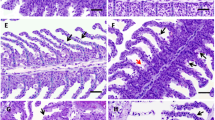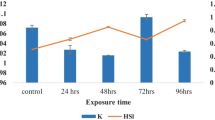Abstract
Brown bullheads (Ameiurus nebulosus) were collected from the St. Lawrence River and compared in their detoxication capacities to bullheads from a relatively non-polluted aquatic system, Lac La Pêche. The content of polychlorinated biphenyls (PCBs) in white muscle was significantly higher (22-fold) in bullheads from the St. Lawrence River compared with those from Lac La Pêche. Activities of liver ethoxyresorufin O-deethylase (EROD), a common Phase I enzyme, were 2.8-fold higher in St. Lawrence River bullheads than in fish from La Pêche. Conjugation activity by hepatic glutathione Stransferase (GST) was 3-fold higher in the St. Lawrence River fish, and significantly higher activities were also detected in kidney and white muscle in these fish as compared with the Lac La Pêche group. UDP-Glucuronosyltransferase (UDPGT) activities in liver and kidney did not differ between the two groups. Activities of cytosolic superoxide dismutase (SOD) were significantly higher, while lower activities of catalase (CAT) in kidney and glutathione peroxidase (GPX) in red and white muscles were noted in the St. Lawrence River bullheads. Concentrations of total glutathione (TGSH) in the different tissues revealed significantly lower levels in liver, kidney and white muscle of bullheads from the St. Lawrence River. The changes in Phases I and II enzymes and TGSH levels in the various tissues relate to higher PCB concentrations of muscle tissue and suggest activation of detoxication capacities, but weakened antioxidant status in the bullheads from the polluted area. The results implicate the involvement of white muscle along with liver and kidney in the whole fish detoxication process.
Similar content being viewed by others
References
Ahokas JT, Holdway DA, Brennan SE, Goudey RW, Bibrowska HB (1994) MFO activity in carp (cyprinus carpio) exposed to treated pulp and paper mill effluent in Lake Coleman, Victoria, Australia, in relation to AOX, EOX, and muscle PCDD/PCDF. Environ Toxicol Chem 13:41–50
Andersson T, Förlin L, Härdig J, Larsson Å (1988) Physiological disturbances in fish living in coastal water polluted with bleached kraft pulp mill effluents. Can J Aquat Sci 45:1525–1536
Beauchamp C, Fridovich I (1971) Superoxide dismutase: Improved assays and an assay applicable to acrylamide gels. Ann Biochem 44:276–287
Burke MD, Mayer RT (1974) Ethoxyresorufin: direct fluorometric assay of a microsomal O-dealkylation which is preferentially inducible by 3-methyl-cholanthrene. Drug Metab Dispos 2:583–588
Bush B, Streeter RW, Sloan RJ (1989) Polychlorobiphenyl (PCB) congeners in striped bass (morone saxatalis) from marine and estuarine waters of New York State determined by capillary gas chromatography. Arch Environ Contam Toxicol 19:49–61
Clarke DJ, George SG, Burchell B (1991) Glucuronidation in fish. Aquat Toxicol 20:35–56
Cohen G, Dembiec D, Marcus J (1970) Measurement of catalase activity in tissue extracts. Anal Biochem 34:30–38
Eckersley M, McCullough R (1990) Fish population trends following the development of the St. Lawrence Seaway: An international Approach. In Messier D, Legendre P, Delisle CE (eds) Collection Environment et Géologie, University of Montreal, Montreal, Canada, pp 401–425
Filho DW, Giulivi C, Boveris A (1993) Antioxidant defences in marine fish-1. Teleosts. Comp Biochem Physiol 106C:409–413
Folmar LC, Gardner GR, Hickey J, Bonomelli S, Moody T (1993) Serum chemistry and histopathological evaluations of brown bullheads (Ameiurus nebulosus) from the Buffalo and Niagara Rivers, New York. Arch Environ Contam Toxicol 25:298–303
Förlin L, Lemaire P, Livingstone DR (1995) Comparative studies of hepatic xenobiotic metabolizing and antioxidant enzymes in different fish species. Marine Environ Res 39:201–204
Fortin R, Mongeau J-R, Desjardin G, Dumont P (1993) Movements and biological statistics in lake sturgeon (Acipenser fulvescens) populations from the St. Lawrence and Ottawa River system, Quebec. Can J Zool 71:638–650
Gallagher EP, Di Giulio RT (1992) Glutathione mediated chlorothalonil detoxification in channel catfish gills. Marine Environ Res 34:221–226
George SG, Wright J, Conroy J (1995) Temporal studies of the impact of the Braer Oilspill on Inshore Feral Fish from Shetland, Scotland. Arch Environ Contam Toxicol 29:530–534
Government of Canada, Ministry of Environment (1991) The State of Canada's environment. Ottawa, Canada, Chapter 19, pp 1–23
Grady AW, McLaughlin RM, Caldwell CW, Schmitt CJ, Stalling DL 1992. Flow Cytometry, morphometry and histopathology as biomarkers of benzo[a]pyrene exposure in brown bullheads (Ameiurus nebulosus). J Appl Toxicol 12:165–177
Habig WH, Papst MJ, Jakoby WB (1974) Glutathione S-transferases. The first enzymatic step in mercapturic acid formation. J Biol Chem 249:7130–7139
Hänninen O (1968) On the metabolic regulation in the glucuronic acid pathway in the rat tissues. Ann Acad Sci Fenn A2 142:1–96
Hasspieler BM, Behar JV, Di Giulio RT (1994) Glutathione-dependent defense in channel catfish (Ictalurus punctatus) and brown bullhead (Ameriurus nebulosus). Ecotoxicol Environ Saf 28:82–90
Kappus H (1986) Overview of enzyme systems involved in bioreduction of drugs and redox cycling. Biochem Pharmacol 35:1–6
Lemaire P, Viarengo A, Canesi L, Livingstone DR (1993) Pro-oxidant and antioxidant processes in gas gland and other tissues of cod (Gadus morhua). J Comp Physiol B 163:477–486
Lowry OH, Rosebrough NJ, Farr AL, Randall RJ (1951) Protein measurement with the folin phenol reagent. J Biol Chem 193:265–275
Mather-Mihaich E, Di Giulio RT (1991) Oxidant, mixed-function oxidase and peroxisomal responses in channel catfish exposed to a bleached kraft mill effluent. Arch Environ Contam Toxicol 20:391–397
Meister A, Anderson ME (1983) Glutathione. Ann Rev Biochem 52:711–760
Munkittrick KR, Dixon DG (1989) Use of white sucker (Catastomus commersoni) populations to assess the health of aquatic ecosystems exposed to low-level contaminant stress. Can J Fish Aquat Sci 46:1455–1462
Munkittrick KR, Van Der Kraak GJ, McMaster ME, Portt CB (1992) Response of hepatic MFO activity and plasma sex steroids to secondary treatment of bleached kraft pulp mill effluent and mill shutdown. Environ Toxicol Chem 11:1427–1439
Munkittrick KR, Van Den Heuvel MR, Metner DA, Lockhart WL, Stegeman JJ (1993) Interlaboratory comparison and optimization of hepatic microsomal ethoxyresorufin O-deethylase activity in white sucker (Catostomus commersoni) exposed to bleached kraft pulp mill effluent. Environ Toxicol Chem 12:1273–1282
Ontario Ministry of Environment and Energy (1993) Guide to eating Ontario Sport fish 1993–1994. Toronto, ON, Canada.
Otto DME, Lindström-Seppä P, Sen CK (1994) Cytochrome P450 dependent enzymes and oxidant mediated responses in rainbow trout exposed to contaminated sediments. Ecotoxicol Environ Saf 27:265–280
Otto DME, Moon TW (1995) 3,3′,4,4′ Tetrachlorobipheny effects on antioxidant enzymes and glutathione status in different tissues of rainbow trout. Pharmacol Toxicol. 77:281–287
Rodríguez-Ariza A, Peinado J, Pueyo C, López-Barea J (1993) Biochemical indicators of oxidative stress in fish from polluted littoral areas. Can J Fish Aquat Sci 50:2568–2573
Schell JD, Jr, Campbell DM, Lowe E (1993) Bioaccumulation of 2,3,7,8-tetrachlorodibenzo-p-dioxin in feral fish collected from a bleach-kraft paper mill receiving stream. Environ Toxicol Chem 12:2077–2082
Scott WB, Crossman EJ (1973) Freshwater Fishes of Canada. Fisheries Research Board of Canada, Ottawa, Canada, pp 588–622
Sen CK, Marin E, Kretschmar M, Hänninen O (1992) Skeletal muscle and liver glutathione homeostasis in response to training, exercise and immobilization. J Appl Physiol 73:1265–1272
Tappel AL (1978) Glutathione peroxidase and hydroperoxides. Meth Enzymol 52:506–513
Weisberg SB, Burton WH (1993) Enhancement of fish feeding and growth after an increase in minimum flow below the Conowingo Dam. North Am J Fish Man 13:103–109
Winston GW (1991) Oxidant and antioxidants in aquatic animals. Comp Biochem Physiol 100C:173–176
Author information
Authors and Affiliations
Rights and permissions
About this article
Cite this article
Otto, D.M.E., Moon, T.W. Phase I and II enzymes and antioxidant responses in different tissues of brown bullheads from relatively polluted and non-polluted systems. Arch. Environ. Contam. Toxicol. 31, 141–147 (1996). https://doi.org/10.1007/BF00203918
Received:
Revised:
Issue Date:
DOI: https://doi.org/10.1007/BF00203918




